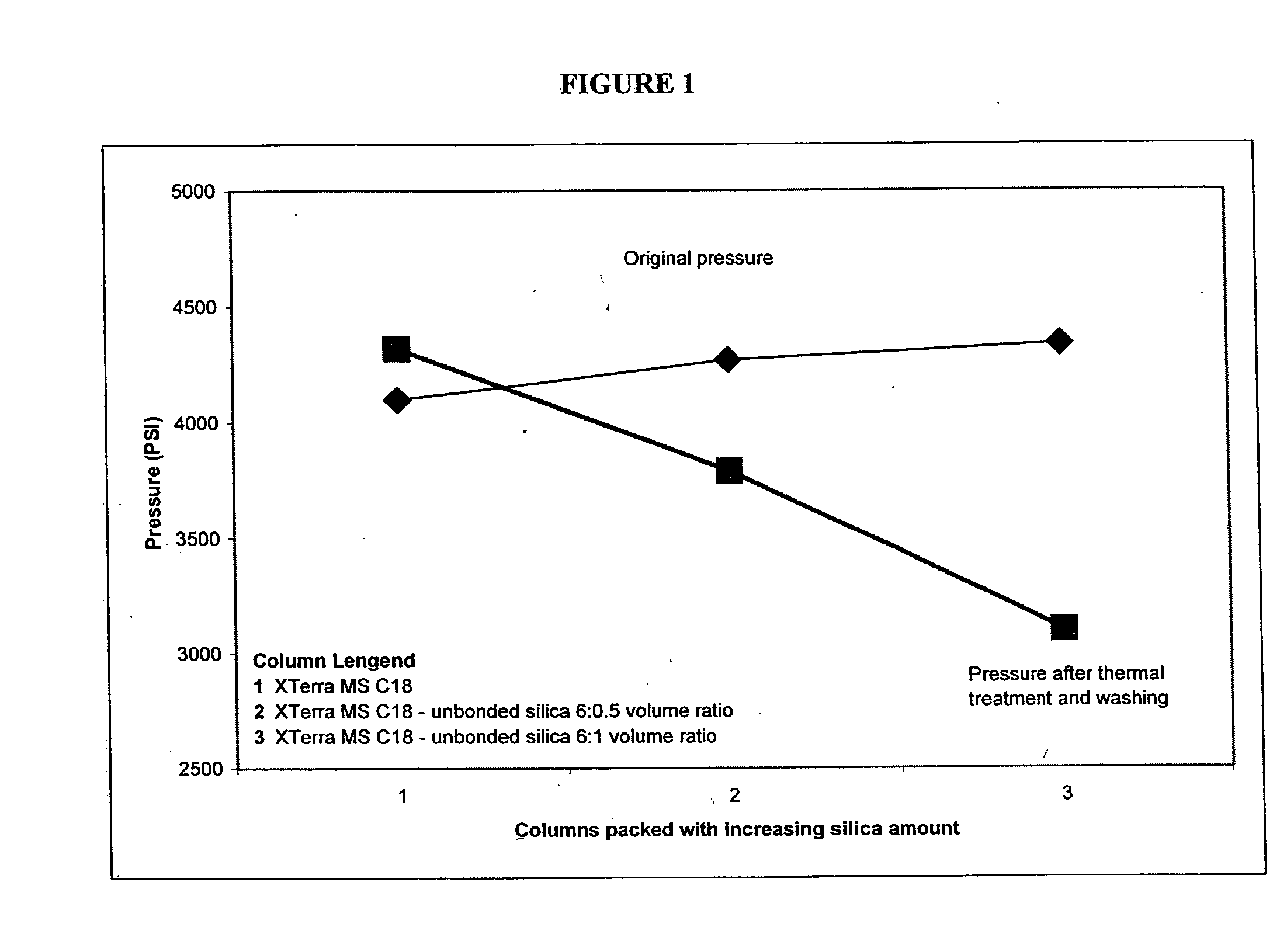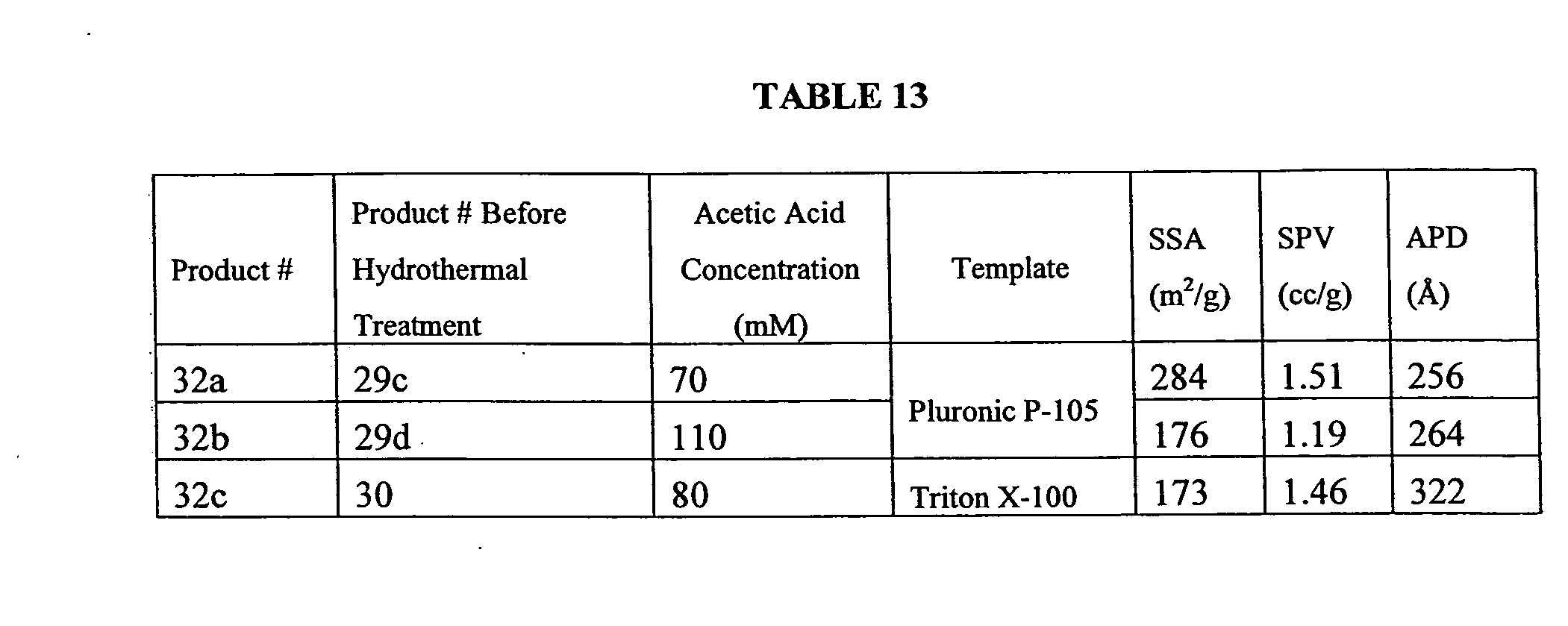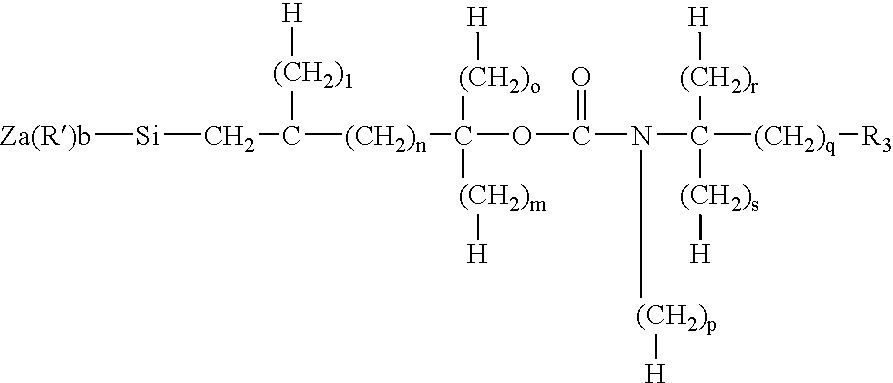Porous inorganic/organic hybrid monolith materials for chromatographic separations and process for their preparation
a hybrid monolith and inorganic technology, applied in chemical/physical processes, natural mineral layered products, synthetic resin layered products, etc., can solve the problems of insufficient separation performance, manyorganic chromatographic materials shrink and swell, and most organic chromatographic materials do not have the mechanical strength of typical chromatographic silicas, etc., to achieve chromatographically-enhancing pore geometry and reduce backpressure
- Summary
- Abstract
- Description
- Claims
- Application Information
AI Technical Summary
Benefits of technology
Problems solved by technology
Method used
Image
Examples
example 1
[0170] An organoalkoxysilane and tetraethoxysilane (all from Gelest Inc., Tullytown, Pa.) are mixed with ethanol (HPLC grade, J.T. Baker, Phillipsburgh, N.J.) and 0.1 N hydrochloric acid (Aldrich Chemical, Milwaukee, Wis.) in a flask. The resulting solution is agitated and refluxed for 16 h in an atmosphere of argon or nitrogen. Ethanol and methanol (if applicable) are removed from the flask via distillation at atmospheric pressure. Residual alcohol and volatile species are removed by heating at 115-140° C. for 1-2 h in a sweeping stream of inert gas or by heating at 125° C. under reduced pressure for 1-2 h. The resulting polyorganoalkoxysiloxanes are colorless viscous liquids. The product numbers and the respective chemical formula of the organotrialkoxysilanes used in the copolymerization with tetraethoxysilane are listed in Table 1. The specific amounts of starting materials used to prepare these products are listed in Table 2.
TABLE 1Used inOrganoalkoxysilaneOrganic GroupProduc...
example 2
[0172] A mixture of a surfactant (Triton X-45 or Triton X-100, Aldrich Chemical, Milwaukee, Wis., ethanol (anhydrous, J.T. Baker, Phillipsburgh, N.J.), and deionized water was heated at 55° C. for 0.5 h, resulting in a white liquid. Under rapid agitation, a solution of toluene (HPLC grade, J.T. Baker, Phillipsburgh, N.J.) in polyorganalkoxysiloxane (selected from Table 2) was added into the ethanol / water / Triton mixture, and emulsified in the aqueous phase. Thereafter, 30% NH4OH (VWR, Bridgeport, N.J.) was added into the emulsion to gel the emulsion beads. Suspended in the solution, the gelled product was transferred to a flask and stirred at 55° C. for 16 h. The resulting spherical, porous, hybrid inorganic / organic particles were collected on 0.5 μm filtration paper and washed successively with water and methanol (HPLC grade, J.T. Baker, Phillipsburgh, N.J.). The products were then dried in a vacuum oven at 80° C. overnight. Specific amounts of starting materials used to prepare the...
example 3
[0173] A mixture of Triton X-45 and sodium dodecylsulfate (SDS) (J.T. Baker, Phillipsburgh, N.J.) or tris(hydroxymethyl)aminomethane lauryl sulfate (TDS) (Fluka Chemical, Milwaukee, Wis.) was used to prepare spherical, porous, hybrid inorganic / organic particles made from the polyorganoalkoxysiloxanes consisting of bis(triethoxysilyl)ethane / TEOS molar ratios of 0.5 and 1.0 (Table 2, products 1i and 1j, respectively). The procedure was the same as described for Example 2, except that the 30% NH4OH was added to the emulsion after transfer from the emulsifier reactor to the stirred reaction flask. The molar ratio of Triton X-45 / SDS or TDS was 1.2 / 1.0. The specific amounts of reagents used to prepare these products (2l, 2m, 2n) are listed in Table 3.
TABLE 3Polyorgano-Mole Ratio:AmmoniumalkoxysilaneOrganosiloxane / SiO2Polyorgano-TolueneEthanolWaterSurfactantSurfactantHydroxideProductFeedstockin productalkoxysilane (g)(mL)(mL)(mL)Type(g)(mL)2a1a0.202400240960X-100201502b1c0.502400240960X-...
PUM
| Property | Measurement | Unit |
|---|---|---|
| Temperature | aaaaa | aaaaa |
| Temperature | aaaaa | aaaaa |
| Temperature | aaaaa | aaaaa |
Abstract
Description
Claims
Application Information
 Login to View More
Login to View More - R&D
- Intellectual Property
- Life Sciences
- Materials
- Tech Scout
- Unparalleled Data Quality
- Higher Quality Content
- 60% Fewer Hallucinations
Browse by: Latest US Patents, China's latest patents, Technical Efficacy Thesaurus, Application Domain, Technology Topic, Popular Technical Reports.
© 2025 PatSnap. All rights reserved.Legal|Privacy policy|Modern Slavery Act Transparency Statement|Sitemap|About US| Contact US: help@patsnap.com



